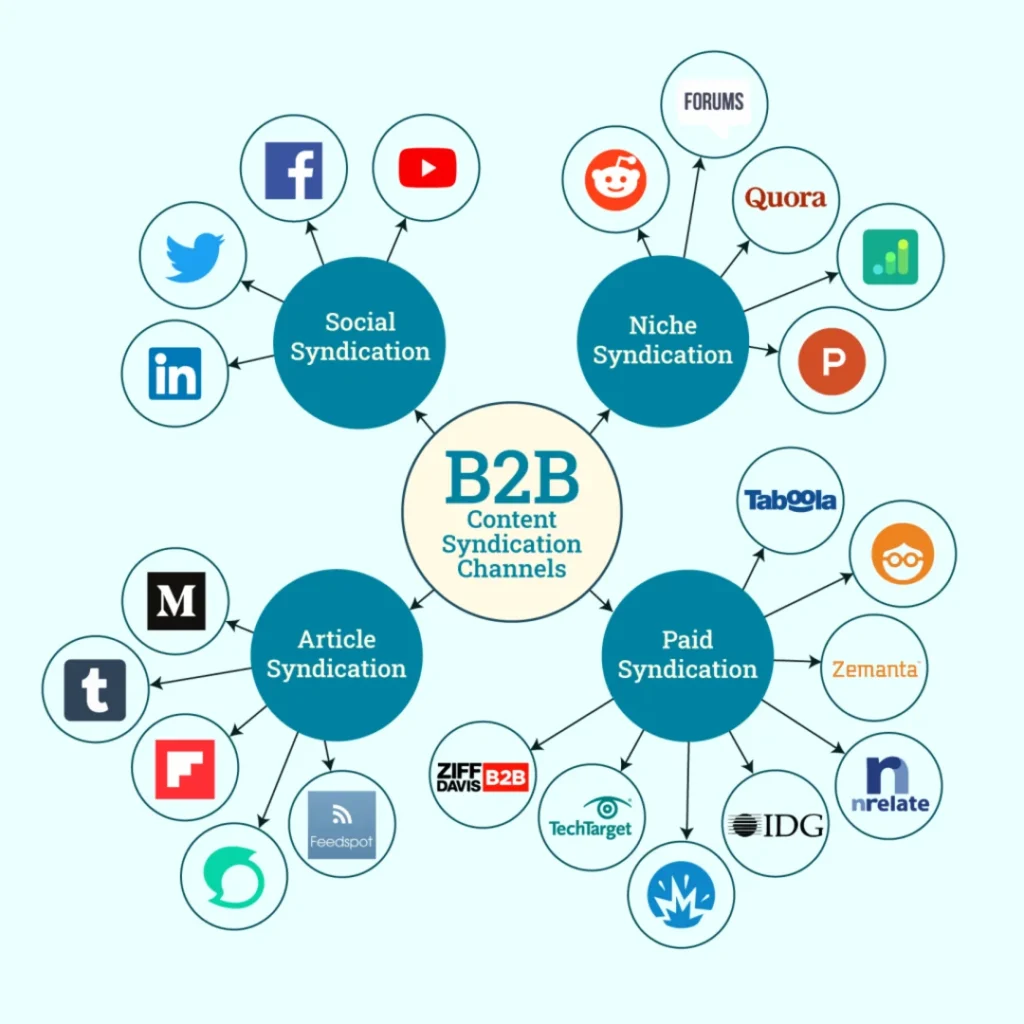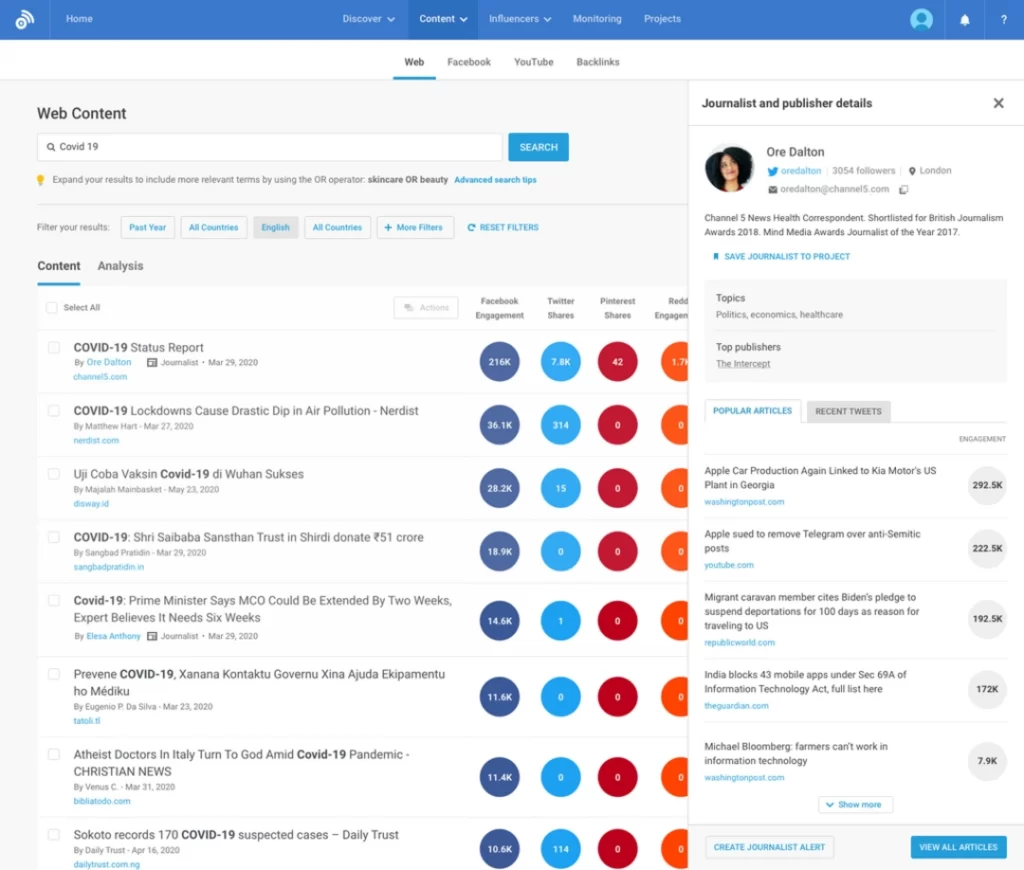Content Syndication: Distributing for Maximum Exposure
Content syndication allows creators to distribute their content to multiple websites and platforms, expanding their reach and viewership. As creating high-quality, engaging content continues, requiring significant time and resources, content syndication provides an efficient way to get more value from that investment.
This article will explore content syndication, its benefits, types of syndication, top platforms, strategy building, maximising distribution, measuring performance, avoiding pitfalls, and even includes frequently asked questions. Content syndication is perfect for your needs if you create content and want more people to find, read, watch, or listen to it.
Table of Contents
What is Content Syndication?

Content syndication is a content creation and distribution model where publishers republish their content across multiple websites and platforms. The goals include:
- Reach new audiences that may not discover or engage with the content on the original site
- Increase overall readership and viewership
- Amplify messaging and brand awareness
- Drive referral traffic back to the original site
- Monetise content by allowing third-party platforms to access it
Rather than only relying on search engines and social media to direct traffic to your original site, you essentially push your content out to places your audience already gathers. This content distribution method allows creators to leverage third-party platforms to share their expertise, perspectives, products, and services.
A Brief History of Content Syndication
While the internet greatly expanded content distribution capabilities, content syndication began long before the digital age. In the 19th century, newspaper editors would exchange articles, allowing them to fill pages at lower costs. This early form of content syndication expanded through the 20th century with significant news wires like Reuters, Hearst News Service, and Associated Press syndicating reporting to outlets globally.
In the 1990s and early 2000s, companies like Moreover Technologies created software for organising and feeding content to portals and hubs that would then distribute it to their audiences. RSS brought increased automation in the early 2000s. And while search engines and social media now dominate online discovery, room remains for syndication. As the creator, you control distribution rather than leaving it solely to algorithms.
Key Benefits of Content Syndication
Creating high-quality, helpful content already requires significant time, money, and effort from your organisation, so why spend additional resources syndicating it? Distribution provides the vehicle for your content to reach audiences and serve its purpose for your goals, making it well worth the investment. Benefits include:
1. Reach New Audiences
Syndicating content directly exposes it to more people who likely will not visit your owned platforms. Even popular sites or creators still only reach a fraction of potential audiences. You can connect with a broader possible audience with more touchpoints.
2. Increase Readership & Engagement
More exposure through amplification and distribution channels will increase readership and engagement metrics. Rather than relying solely on ownership, you diversify discovery paths. Open up your content for third parties to access; they will likely have tools, incentives, and opportunities to share it broadly with engaged users. Overall impressions and actual consumption can experience significant gains.
3. Referral Traffic & Links
Most content syndication options allow linking back to your owned domains from the distributed content. As a result, new referral pathways direct fresh traffic back to your platforms. Links also build domain authority for SEO wins.
4. Brand Awareness
Expanding your online footprint exposes your brand, messaging, products, and services to wider audiences in more places. Appearing as a thought leader or expert source on different sites builds familiarity and trust.
5. Monetisation Opportunities
From receiving direct syndication licensing fees to driving traffic for advertising, lead generation, and sales, syndication creates new monetisation paths. Even indirectly, the increased visibility and referral traffic can provide revenue value.
Reaching and engaging wider audiences while benefiting your owned platforms makes content syndication an impactful distribution tool.
Types of Content Syndication

Content syndication comes in a variety of shapes and sizes. Your chosen model depends mainly on content type, available time/resources, goals, and ideal partners. Let's explore some of the most common options:
RSS Feeds
Simple Syndication (RSS) utilises feed formats to distribute content updates directly to users. Rather than visiting sites, audiences can subscribe to receive regular updates. This requires little effort to set up, provides automatisation, and expands reach through reader aggregation platforms. However, RSS limits branding and offers little control.
Sponsored & Guest Content
Seeking sponsored posts and guest contribution opportunities allows you to tap into interested publishers’ built-in audiences. You provide the content that aligns with their readership for exposure. This elevates authority and links back. However, the lack of control and effort to manually pitch ideas provide some downsides.
Content Partnerships
Establishing formal content partnerships designates agreed syndication opportunities with other publishers. This provides ensured distribution but requires more effort in establishing guidelines. Appropriate partnerships multiply exposure.
Content Marketplaces
Numerous platforms like NewsCred, Budget Direct Syndication, and AdSupply aggregate content for licensing opportunities. You upload assets for publishers and marketers to access for fees. This provides passive income but with little input into how content appears.
Social Media
While not pure syndication, social platforms provide their distribution within walled gardens. Tailoring content for engaged communities on Facebook, LinkedIn, Twitter, Pinterest and more helps reach built-in audiences. Optimisation remains key.
Multimedia Platforms
Media hosting platforms also centralise content access points for their viewers. YouTube, Vimeo, Spotify, and SoundCloud offer creators tools for externally sharing formats like video and audio.
The options above provide a sampling of models, each providing its pros and cons. Multi-tier distribution across many options creates an overlapping web of syndication touchpoints optimal for maximising amplification.
Top Platforms & Publishers
Which websites, platforms, and publishers you distribute through depends largely on your content and target audiences. Rather than blanket blasting content indiscriminately, an intentional approach ensures optimal visibility and engagement. Here are some top channels to consider for syndication:
- News & Magazine Sites – Publishing content on mainstream news, magazine, newspaper, and media publisher platforms tremendously expands category and topic-specific reach. Pitching contributing opportunities or utilising content marketplaces can help land placements.
- Blog Networks & Directories – Blog content syndication networks aggregate content for distribution to their roster of websites and channels. Directories act similarly. Becoming a contributor expands reach.
- Industry Hubs – Industry-specific publisher hubs centralise insider content for their niche. Aligning your content with platform readership helps penetration.
- Multimedia Platforms – Again, sites like YouTube, Vimeo, Spotify, Podbean and more provide their audiences and sharing tools. Upload content directly for built-in amplification.
- Social Networks – Getting content shared socially may not constitute syndication, but it does expand visibility greatly. Optimising assets for such engagement is wise distribution.
- Aggregators & Portals – Sites like Yahoo News, Flipboard, and other aggregators collect and share content with visitors. Seeking pickup can gain a referral audience.
- Influencers – Relevant bloggers, journalists, creators, executives and influencers who align with your content from their syndication points. Pitch them or respond to contributor requests.
Drilling down specific categories, topics, and platform synergies between your expertise and their audiences helps get the best returns on syndication efforts.
Building an Effective Content Syndication Strategy

Thus far, we have covered what content syndication entails, why it brings value, the formats it can take, and potential channels. With the basics established, how do you build an effective, scalable syndication strategy? Follow these steps:
Audit Content Assets
Review all existing and planned content your organisation creates. Inventory-owned blogs, videos, podcasts, ebooks, guides, etc. Then, analyse performance. Which currently performs best in driving traffic, links, conversions, social shares and visibility? Does any content fill apparent gaps? Use these insights to guide plans.
Define Goals, Targets & Metrics
Clarify what specific business, brand, and content goals syndication should achieve – whether awareness, traffic referrals, conversions, etc. Then, set numeric targets tied to KPIs that align with those goals for performance benchmarks. This grounds the strategy in tangible outcomes.
Research Distribution Channels
Research channels and publishers that reach your target audiences and align with top-performing content. Explore news sites, blogs, multimedia platforms, aggregators, social media, forums, and influencers. Find ones receptive to contributor content or already sharing content similar to yours. List top picks.
Produce Optimised Syndication Assets
Then, create designated content assets suited for syndication distribution channels—Optimise piece length, formats, design, etc. Producing unique material directly for syndication prevents over-relying on one-size-fits-all content. It also shows respect for publisher guidelines and audiences.
Pitch & Distribute Content
With research and syndication-tailored assets ready, actively pitch your content and make distribution deals. Utilise multi-channel best practices for outreach. Leverage existing relationships. Provide value to partners while benefiting their goals—Automate where possible.
Track Performance & Optimise
With regular distribution up and running, closely monitor metrics tied to the goals set. Which content and channels perform best and worst? What achieves the highest visibility, engagement, conversions and referrals? Use analytics to guide evolving strategies. Double down on what works and cut poor fits. New opportunities also emerge over time as partnerships strengthen. Continual optimisation ensures consistent wins.
Expand Efforts Over Time
View syndication as an investment that compounds gains over longer time horizons. As you better understand audiences and channels, increase content volume and platform breadth. Constantly produce new assets and test partners. Set next-level goals and challenges. Avoid stagnation. The above framework sets the stage for scope, reach, and impact expansion, along with the continued perks for your brands, sites, and organisation.
Approaching syndication strategically, in a targeted and ever-growing way, provides the best results rather than sporadic, random sharing. Patience and persistence pay dividends.
Maximising Content Syndication Distribution
What other tips and tricks boost syndication reach and sharing even further?
Along with core strategy principles, various best practices increase content distribution velocity and amplification. Consider the following:
Follow Publisher Guidelines
Always carefully adhere to specs and rules set by syndication platforms and publishers. Submitting content correctly shows respect while increasing pickup and performance likelihood once live.
Write Compelling Headlines
Like all content, attention-grabbing yet descriptive headlines attract engagement. Spend significant time wordsmithing syndication headlines specifically.
Write Strong Meta Descriptions
The accompanying meta descriptions also sway clicks and shares. Carefully optimise these snippets to provide intriguing synopses.
Insert Images & Embeds
Relevant images, videos, charts and other engaging embeds peppered throughout syndicated posts make them more eye-catching and digestible during scans.
Feature Guest Contributors
When possible, recruit industry experts, influencers and authors to co-create content for syndication. Feature their names and expertise to boost credibility.
Promote Syndicated Content Releases
Don’t just syndicate and forget. Promote content launches across owned, earned and other channels. Remind audiences of pieces once live. Mobilise internal teams to share, too.
Repurpose Top Assets Continually
The best-performing assets warrant continual re-syndication to new channels over time. For evergreen long-form content like guides, refresh and rerun distribution repeatedly.
Tag Appropriately
Proper tagging and categorisation ensure content surfaces are most qualified in searches and recommendations. Choose descriptive identifiers suited for each publisher community.
Update & Feature Old Content
Update evergreen content, then resyndicate as “refreshed for 2024”, etc, to capture new audiences. Or compile/feature past content compilations to re-promote.
Constant optimisation and innovation in approach keep syndication revenue channels flowing.
Tracking Content Syndication Performance

Measuring content syndication performance remains imperative for continually improving strategy. Why invest scarce resources if you cannot connect distribution to tangible business results? Tie syndication analytics to critical metrics:
Traffic Referrals
This key metric shows the direct value of syndication in driving new visitors from placements to your owned properties. Prioritise partners sending growing referred audiences.
Content Engagement
Measure impressions, clicks, average time on page, scroll depth, and other engagement metrics for each syndicated content item. This indicates interest and quality.
Conversions & Sales
Ultimately, syndication should influence desired actions like email signups, purchases, registrations, and downloads. Connect placements to conversion jumps.
Social Engagement
Track social shares, likes, and clicks achieved through syndication placements to show enhanced reach and amplification.
Backlinks
Placements on other domains should link back to yours. Monitor new quality backlinks secured via partnerships along with resulting SEO ranking boosts.
Ongoing performance analysis directs winning strategies while exposing ineffective partnerships missing the mark. Data minimises guessing games. Review analytics regularly within a dashboard or reports.
Pitfalls to Avoid with Content Syndication
While a beneficial distribution tactic, content syndication does come with a few potential downsides to consider:
- Requires added effort and resources for content production, pitching and distribution – taking away from core content or other priorities
- Limited control over how syndicated content appears on third-party sites
- Potential brand safety issues if paired with low-quality or controversial publisher content
- Oversaturation is sharing the same assets repeatedly
- Mismatched content and audiences when not intentional about partnerships
- Indistinguishability if the content becomes too similar to the publisher’s style
- Difficulty tracking detailed analytics on third-party performance
- Lost momentum or consistency without continual creation and distribution
However, positive outcomes outweigh these risks when syndicating thoughtfully. The specific strategy steps outlined earlier help minimise negative issues that do pop up. Monitor closely and keep iterating.
Conclusion & Summary
Content syndication provides creators and brands a valuable distribution model for reaching wider audiences beyond owned channels in an increasingly fragmented media landscape. Strategically repurposing high-performing content by publishing directly on targeted external platforms taps into discovery streams and built-in communities. This amplification expands awareness, drives engagement, secures backlinks, lifts conversions and referral traffic, and may even generate direct licensing income.
To maximise results, audit your assets, define goals and metrics, research ideal partners, produce custom syndication content, distribute systematically, promote placements, track analytics rigorously, and then double down on what delivers ROI while improving poor fits. Patience and persistence allow compounding gains over time.
Used intentionally and consistently, content syndication should become a standard distribution play for innovative content marketing strategies. Now, put these tips into action and watch the perks unfold.
Frequently Asked Questions (FAQs)
What types of content work best for syndication?
Given its usefulness over time, evergreen, informative long-form content like guides, how-tos, and listicles perform well in syndication. However, don’t limit yourself to only specific formats. Leverage multimedia and test a variety.
How much-syndicated content should I create?
Ideally, continually produce new syndication-specific assets like blog posts and videos. Repurpose and update evergreen content, too. More volume over time maximises exposure. But focus initial efforts only on publishing a few targeted, high-quality pieces. Then, build consistency.
What does a successful syndication partner look like?
The best partners reach your target audiences and demonstrate engagement, sharing cultures, and referral traffic rates that provide visibility and conversions. Niche sites and influencers sometimes outperform general publishers. Evaluate thoroughly.
How do I pitch my content for syndication?
Follow publisher guidelines closely—Personalise queries to editors. Communicate digitally and follow up. Share past successes and traffic metrics proving your assets deliver engagement. Remain patient through reviews and revisions. Provide lots of high-performing ideas.
Is syndication worth the effort compared to organic reach?
Syndication provides complementary amplification beyond organic channels alone. The compounded gains warrant additional effort to unlock exponentially broader distribution potential. Just maintain realistic expectations around required investments. Start small.
